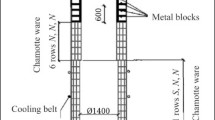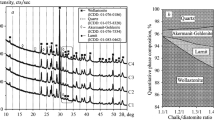Conclusions
The optimum conditions for melting magnesite into blocks using the OKB-514 electric furnace can be considered a voltage of 97 volts on the low side and a mean hourly charge of 50 kilograms. Of the methods of feeding powders to the furnace that were tried out, the continuous method is the most efficient.
Parts with high properties can be machined from blocks of fused basic refractories.
Parts made by the ceramic method from fused materials, including from a mixture of fused and sintered powders, are marked by high density (porosity 13–19%), refractoriness-under-load of 2 kg/cm higher than 1800°, and spalling-resistance of 5–15 heating-cooling cycles when cooled in water from 1300°.
Using the OKB-514 furnace, with reduced periodic feeding, it is possible to produce fused magnesite containing up to 98% MgO when the initial raw material contains 90% MgO. The part of the block (10–15%) with the high MgO content can be separated during the finishing operation.
Similar content being viewed by others
Author information
Authors and Affiliations
Rights and permissions
About this article
Cite this article
Ivanov, Y.V., Gaodu, A.N. & Guzenko, G.S. Melting refractory materials in the OKB-514 electric furnace and making parts for them. Refractories 2, 169–174 (1961). https://doi.org/10.1007/BF01301111
Issue Date:
DOI: https://doi.org/10.1007/BF01301111




